The Oakland A’s have just released their detailed plans for building a new 34,000-seat baseball stadium on the city’s 55-acre Howard Terminal site, adjacent to Jack London Square.
As designed by Bjarke Ingels Group (BIG), an elevated park would frame the ballpark’s bowl, “coming down to meet the waterfront” and surrounded by a futuristic development of new housing, offices, restaurants, retail, hotels, parks and public gathering spaces.
Ambitiously positioning to break ground in 2021 and open in the spring of 2023, the new “ballpark district” is envisioned to “sit neatly within the extended urban fabric of Oakland, transforming the ballpark’s concourses into street, and concessions into restaurants” and “ensure the ballpark, and the park that sits atop it, are active on game days and non-game days alike.”
In addition, the A’s are lobbying to purchase and redevelop the existing 111-acre Coliseum site into a new tech, housing and retail hub, re-purposing Oracle Arena as a concert and events center and turning the original Coliseum baseball diamond, sans its surrounding structure, into an open amphitheater and central park.
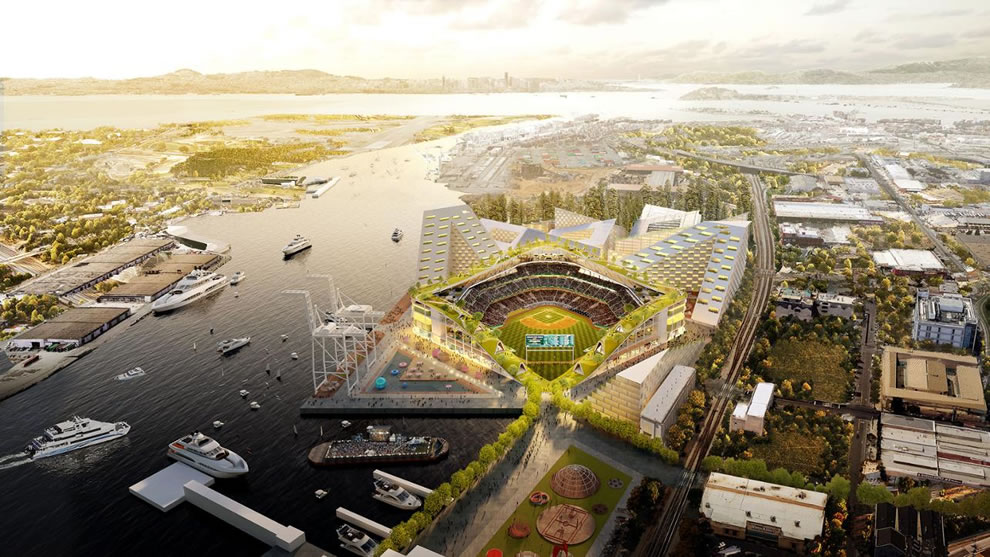
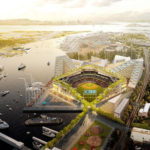
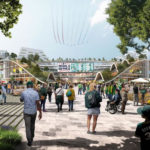
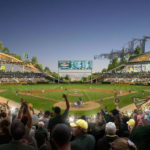
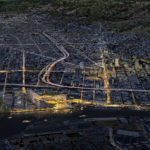
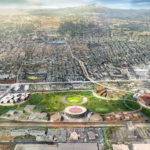
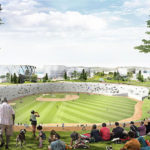
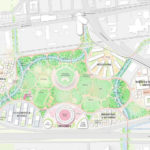
Let’s hops the city isn’t stupid enough to sell the coliseum site to these guys. They want to purchase it for far below its true value. The city should carve it into 1000s of lots and lease them to developers. A site like this should easily house 10000 people.
Right and the city should zone it for a minimum density. That site is bordered on all sides by freeways, railways, and waterways so building height should not raise much neighborhood opposition.
you mean maximum density
I actually meant what I wrote (and agree with you) though I can see how the wording is confusing. What I meant is that it should be zoned with a constraint like “There should be a minimum of X housing units per acre”.
Wow that thing is WILD. We’ll see how the design fares after the approvals…
What an awesome plan! I’m hoping this becomes a reality. Think about how cool it would be to take in a double header: day game at this new Howard Terminal park, and then take an evening ferry across the Bay to AT&T. Simply baseball magic!!!
You’d want to reverse that and get yourself better weather for both games.
Yes, this plan works both ways 😉
I just don’t understand the fascination with the Howard Terminal site other than as a misguided attempt to ape China Basin. It simply doesn’t work on so many levels.
As a very avid fan (who has attended every park in MLB save for Atlanta’s new yard), I would have no interest in going to a game in that concoction Ingels came up with. What do Danes know about baseball, anyways?
Why not? The outside might be funky but I see a baseball stadium inside that will be on par with any other baseball park in the league. The goofy stadium V for outfield probably means that the outfield seating tapers or will be minimal, standing room tickets. But I like being off first and or third base because you get to see the pitching & field where most of action is to begin with. Nor do I see outfield seating really that great of a game day experience anymore and rather see a few less games than sit in the cheap seats & spend the game watching an oversized TV.
In same breadth, I would argue that some of the older baseball stadiums were not that great of an experience. Old Yankee stadium was only good when you sat in your seat in my opinion. Otherwise crowded narrow passageways shared with load drunk New Yorkers and no room for concession space or catch some elbow room. This was on top of my experience seeing a cop dragging a bum away from car after claiming he was hit by a car. But hey, Port of Oakland experience might up their with my going into the Bronx experience.
Wrigley is great if you know enough not to get seats behind a column. Get the wrong seat in Wrigley and you stared at a column for half the game and the seats in the outfield for day games are great if want to get drunk with the rest of the crowd playing hooky.
Heck, some of the stadiums that have come and gone were pretty sad for baseball. Twins playing in the Metrodome with the white roof & bouncy astro turf as an example before they got a baseball only stadium.
Agree with Orland, I wish it felt more “American” in design and character. That’s what I want to feel when I go to “America’s game”.
-spoken by an immigrant
Thank you. This thing is a hot mess, looks like BIG just hit copy/paste on an old design and applied it to a baseball stadium.
Agree that this might be the project where the world realizes that BIG ain’t wearing clothes, but I’m glad it’s not a lame copy of Camden Yards either. Whoever photoshopped that scoreboard on axis and forgot to include the batter’s eye needs a talking to, but then the whole concept is ruined by those things anyway.
the howard terminal plan looks pretty cool, though still far from bart – maybe they can build a people mover from west oakland or something.
but that other plan for coliseum looks way too sparse (yeah green space is nice to have, but it seems a bit much for this spot so close to highways and bart).
Understatement. A site served directly by both BART and a mainline railroad station needs to contain lots of residential and numerous work and commercial destinations. Oakland is already saddled with an abundance of economically non-performing parkland and open space. We really don’t need more. What we do need is more walkable, dense residential districts well-connected to the rest of the city by existing transportation investments.
Also the fanciful appearance of the two creeks in this site rendering will strike the well-informed as a joke. Those creeks are probably the two most polluted waterways in America. The 73rd Ave ditch is polluted with PCBs and VOCs and the other ditch runs through the foundry with a plume of leaded gasoline, TCE, chromium, and other pollutants under it. Indeed, the place where this absurd site plan shoves all the residential buildings is adjacent to several parcels with deed restrictions forbidding residential.
I highly doubt that the dev team really wanted to make so much of that Coliseum spot parkland to begin with, but that it was the only way to make it politically viable and get support from East Oakland and probably came directly out of the community engagement process. Also “saddled with an abundance of economically non-performing parkland”… lol, go take a walk brother.
That plan they put out for the Coliseum site has no chance of being adopted. It will end up having more residential, more commercial/office, and less open space… as it should. Also, the idea of retaining Oracle is more likely than not a very, very bad idea. Same goes for the Coliseum footprint being retained as a public baseball field. Terrible use of space that won’t perform well economically or have a reasonable size-to-utility cost benefit.
Retaining Oracle Arena makes perfect sense. Oracle is still a fine facility which was completely renovated in 1997. The Warriors would love to see it come down but that’s not going to happen. It will be there willing and able to undercut Chase Center in congested San Francisco.
Without reducing capacity (to fill a different segment of the market) and/or massively reducing the cost to hold events there, Oracle will not be able to successfully compete against both SAP Center and Chase Center (not to mention Golden 1 Center not far away in Sacramento) to attract events.
There are numerous examples of this problem in metropolitan areas across the country. The only regions that at least somewhat successfully see 3+ large arenas operate are greater New York and greater Los Angeles, both of which have much larger and more geographically even distributed populations.
Take Chicago for instance. The Combined Statistical Area (i.e. the greater metro area) it is a part of has a total population of 9.9 million and only one large arena, the United Center at 23,500 max for an event. The next largest has a capacity of just 10,000.
The SF-Oak-SJ CSA (includes all of the greater Bay Area region) has 8.85 million people. It has 2 large arenas in SAP (19,190 max) and Oracle (20,000 max) with another in Chase (18,064+) on the way. This doesn’t even include the Cow Palace (16,500 max) on the lower end of the event tier and price point spectrums. Haas Pavilion is the only thing really in the mid range, but has restrictions on types and number of events that can be held there. That’s the niche where a reduced capacity Oracle could compete.
If you don’t do that, then good luck filling enough slots and generating enough revenue at Oracle to compete in that environment.
We have to remember that the East Bay is the largest region in the Bay with 2.7 million residents. SF and the Peninsula are not even close. Also, Oracle Arena is just as nice if not nicer than SAP arena in SJ. I don’t see why Oracle would have to shrink from being the biggest arena in the most populated side of the Bay. The Warriors will have something to worry about with Oracle Arena sitting there as a viable alternative.
You didn’t bother to address the point and are now trying to perpetuate the delusion that Oracle is and will be more attractive to events than 2 other newer and more well-equipped venues. If you want to believe that nonsense, go ahead. But it’s not consistent with the observable realities that we see in the Bay Area and around the country.
Have to agree with A on this one. At some point you have too many seats for the year and not enough events to fill them. Chase Center will change the dynamics even with SF congestion and sure there has been a few people stuck in the Nimitz parking lot of I880, East Bay version of congestion that is alive and well.
If the waterfront ball park location is approved (regardless of the final design) this should keep Oakland property values, at least north/west of High Street, on the rise, or at least give them a bit better padding during a significant downturn.
In overall feng-shui it is, IMO, 10x better to put the ballpark there, near DTO & lake merritt, vs. buried way down in the pit of Deep East Oakland.
Sticking a new park at the existing Coliseum site would likely result in the stagnation of game attendance & interest because it’s a slog to get that far down into Oakland, and the surrounding area *sucks*. A new ballpark at Coliseum would not be enough to “pull up” the bad areas around it.
By putting the new ballpark near DTO it will only accelerate the revitalization which is already underway in that area, which’ll be a lot easier (and more successful) than trying to drag DEO up by building anything new in No Man’s Land.
Utter nonsense. Building up a ballpark neighborhood around a new facility at the Coliseum site could do wonders for the site and the surrounding area. This is a missed opportunity to build a modern and better Wrigleyville. Meanwhile, HT has no direct access to mass transit (ferry service is a drop in the bucket) and likely won’t for, at a minimum, decades. No mention that that whole “stadiums drive revitalization” is a myth. There’s a mountain of evidence proving that they don’t. The cases where revitalization has occurred around stadiums/arenas are overwhelmingly the result of other social and economic forces, not a result of the sports facilities.
If we’re being honest, stadiums/arenas are pretty objectively a waste of space from an economic perspective. Now, of course I’m in favor of still having pro sports and the associated facilities for them to occur. But this raises an important point. If the argument is going to be made that the Coliseum site is better off being used for non-stadium development, then you absolutely have to make the same argument about Howard Terminal, and vice versa.
Why don’t they see the obvious?
Disagree, only way you are going to get your Oakland version for Wrigleyville is if the community college board didn’t cave in so easily to a student body and faculty that ignore the financial benefits of giving up an administrative site. What would have been cool about the Lake Merrit site is that the Wrigleyville like atmosphere would have had a major Asian twist to it.
I do agree with the comments of what is being proposed for the Colesium site is underwhelming at best and as noted by yourself, the idea of green park space around heavily polluted creeks is fanciful not realistic. Time to upsize the housing, commercial, and office on the site, add some selective pocket parks, ballfields to a site with some of the best transit/freeway/airport access in the Bay Area. The whole notion is that its better suited to keep the A’s there boggles my mind. The A’s will want to keep the parking lots and parking revenues that go along with it, and so on.
Demolishing a community college in a historically underprivileged city and in a particularly socially vulnerable part of the city today, all in order to let a sports team build a venue, was never going to fly.
Oakland is not an underprivileged city. Oakland is one of the better to do big cities in the United States. Oakland has some of the wealthiest and best educated neighborhoods in the United States. See: Rockridge, Claremont Hills, Montclair, Crocker Highlands, Trestle Glen, Ridgemont, JLS, etc.. Also, lower poverty rate than NYC, LA, Chicago, Miami, etc..
“Oakland is not an underprivileged city”
Yes it is, both historically and currently in terms of relative area income, poverty rates, crime, and more. Mountains of data bear this out. No amount of denial will change the facts of Oakland’s history. It’s not an insult. It’s a statement of fact. Denying it is doing an anti-reality disservice to the entire city.
Absolutely not. Only SF, SJ and Seattle (barely) have higher home values than Oakland of all big cities in the United States. You are trying to perpetuate an inaccurate stereotype about Oakland. Oakland is one of the better to do major cities in the United States based on home values, rents, education levels, poverty levels, etc.. In California, Sacramento, Long Beach, Fresno, LA, Bakersfield, all have higher rates of poverty.
Demolishing a community college? I don’t think that’s what was being proposed.
No it wasn’t – the only ones ‘demolishing” Peralta are the Board thru their fiscal mismanagement – but it helps push the narrative of “Poor Oakland” (in several meaning of the term). In reality Oakland is b/w the extremes ‘EG’ and ‘anonymous’ have claimed.
As for the Plans themselves: long on “vision” and short on practical things (like parking); would be nice to see ground level views and fewer birdseyes.
The saying is go big – BIG? – or go home…seems like they’re trying to do both.
Takes a special kind of ignorance to equate high gross home values with good relative socio-economic health. By that line of thinking, upscale suburbs of much lower cost of living metros (which often have homes prices lower than the Bay Area average) are socio-economically worse off that pretty much any and all of Oakland (or Richmond, or the Bayview, or , or, or)… which is an absurd claim on its face.
Been following your comments for years, E. Gonsalves. Lately you seem to have moderated yourself with the Trumpian gas-lighting about “how great Oakland is” and how it’s a world-class city on par with SF, yadda, yadda, yadda…. Until this unpleasant reminder that you continue to harbor a strain of outright denial about just how crappy all of Oakland from southern Emeryville to San Leandro, below 13 & 580 freeways, really has been, *for five decades.*
5 years into active gentrification and *improvement*, the lower half of Oakland is just barely starting to emerge from 2nd-world-nation standards of conduct and living. Half of Oakland (contrary to disaffected hipster adulation, whether of the Boomer, Gen X, or Millenial strain) has been a true cesspit for a very long time.
The trash-binning of Desley Brooks just a few weeks ago, finally, signals that the crap half of Oakland may be able to garner a bit of provisional respect from outsiders (i.e. non Kool-Aid drinkers.) It’ll be at least another 5-10 years along the gentrification/improvement path (should it continue, economy permitting) before Bad Old Oakland becomes stronger in memory than in present reality & everyday experience.
The above delivered to you at the pleasure of a 4+ year Oakland resident, property owner, and transplant from Another Place with *normal* American middle and/or respectable working-class expectations for civic conduct, respect for the law, etc etc.
I don’t agree at all with your very negative portrayal of Oakland. There are plenty of nice vibrant areas below 580. Lake Merritt, Adams Point, Gold Coast, JLS, Uptown, Old Oakland, City Center, Chinatown, Eastlake, Ivy Hill, Maxwell Park, Millsmont, Fruitvale, Gingletown, etc.. I happen to like the color, flavor and vibrancy of Fruitvale even though you may see poor Brown people as visual pollution. Also, I never said San Francisco was a world class city. Oakland is a prettier town with much more parkland and a beautiful lake right next to downtown. Are you sure you’re from Oakland?
E. Gonsalves — I said nothing at all about the color of any people. I said specifically “2nd-world-nation standards of conduct and living.” To wit:
– Chronic trash-dumping in the streets.
– Keeping chronically noisy animals.
– Arrogantly and often chronically destroying other residents’ right to peace and quiet.
– Raising children who have a higher-than-normal active contempt for the basic laws of any civil society, e.g. not murdering other people over petty matters like drugs, small amounts of cash, perceived social disrespect, etc.
Bleeding-heart and empty-pocketed liberals will appreciate my completely race-blind attitude towards all these problems. I don’t care what color the people are who are taking the above-described actions on a daily and hourly basis. Not my problem, in fact, it’s symptomatic of excessively liberal moral sickness.
An attitude of excessively “loving” “tolerance” for all of the above is nothing more than artfully and devilishly masked *pity*.
Think before you next type out some imputed accusation of racism where none is merited. It just exposes your own projected / masked and in the larger picture, *pitying* exceptionalism on the basis of “colorful culture” and your aesthetic preference. Which I suspect is most likely founded on your not living anywhere directly-exposed to these problems all day, every day.
Elmano, bro, you are literally not from and do not live in Oakland. You have admitted this numerous time over the years.
Oakland is so much prettier and more world class that it’s skyline is universally recognizable around the world and everyone knows about Lake Merritt and the Tribune Tower and JLS while nobody has ever heard of or seen Coit Tower, the Golden Gate Bridge, or Lombard Street. Oh wait…
There are lots of great things about Oakland. The claim that it is considered to be more “world class” than SF is so offensively and willfully ignorant that it should be punishable by being strapped to a rocket and launched into the sun.
I agree that the Howard Terminal site is sub-optimal due to isolation & lack of transit options. The Peralta CC site would have been nearly ideal but we all know Oakland loves its progressive image considerably more than baseball.
Just curious where you get your Oakland recon?
Investing money in a new stadium at the existing site is risky. That area is so trashy and ugly, and nothing is nearby is of any interest. I am sure some very knowlegable individuals performed a thorough analysis before deciding on Howard Terminal. I trust the professionals way more.
Let me know how that’s worked out on the last half dozen A’s stadium plans, including a major failure within the past year.
This is only the second legitimate attempt to build a ballpark in Oakland. The others were all about taking the A’s from Oakland. No one those plans to succeed except Lew Wolff and his San Jose boosters. Let’s not conflate any disingenuous attempt by Lew Wolff and Steve Schott as real efforts to build in Oakland. Laney and now Howard Terminal are the only real efforts ever made by the A’s to build in Oakland.
Wolff sold his share of the A’s in 2016
There you go, lying about and distorting reality again. It’s a FACT that the A’s have made several concerted stadium efforts both inside and outside of Oakland. You don’t get to dismiss the ones you feel like because they happen to challenge your infinitely delicate sensibilities (or lack thereof).
ABAG should also be held accountable right now and speak to the sea level and SF Bay water level rise that not only begin to eat away at this proposed property within 15 years of development, but also how and why they let (apart from big money from NBA and Chase on the table) the Warriors firstly leave a perfectly good developmental build site tearing the heart out of one of Oakland’s Crown Jewels of sport, only to land in the already crowded and housing diminished(think of all the housing that could have been ready in SF if the level of building was pressed as hard for the new Warriors Chase Complex to open in a matter of months)Mission Bay and how they too,will have to begin paying for and raising further bond measures to taxpayers for private companies that build in sea level rise due also to effect the holdings of the Chase Center on. The banks of the Bay.
That is an excellent point. in my enthusiasm I had forgotten about ACC (anthropogenic climate change) and sea level rise. A crucial structural challenge to be considered / planned for at the waterfront location. (At the Coliseum site as well, though it might be 5 or 10 feet higher elevation.)
Howard Terminal has to be at least 10 ft above the water level. This is the dock where all the huge container ships dock.
Literally nobody should believe this is going to happen until ground is actually broken. We’ve seen the A’s go through a downtown site (killed by then mayor Jerry Brown), Victory Court, various Coliseum site musings, Fremont, Diridon in downtown San Jose, Laney, and now Howard Terminal.
There are also more challenges to be overcome with this site than with any other. ANYTHING is an upgrade over the current Coliseum facility, but it’s foolish to think what they revealed today is something even resembling a slam dunk, or even a layup.
Loooooooooong way to go here. Buckle up.
True, but this was all said before re: AT&T (old Pacific Bell Park). It very well may happen.
I understand why that trope is repeated. It seems like a good comparison at face value. But the public, regulatory, economic, and social climate that enabled AT&T to happen presented many fewer obstacles to get it done. It will be an order of magnitude more difficult in today’s Oakland.
What “climate?” So much SF snobbery. Why is this “order of magnitude more difficult?” Because of the relentless negativity and negative press coming out of an insecure SF which can’t stand the thought of Oakland outdoing it in any way? Give me a break with this provincial SF-centric nonsense.
Why don’t you try addressing the point and talking about facts rather than whining in delusional non sequiturs, Elmano? You entire m-o for the past decade has been to go around trolling about how everything SF sucks and everything Oakland is great.
Just a reminder that Elmano here constantly boosts Oakland despite not being a current or former resident, by his own admission. Meanwhile, feel free to peruse back through some articles on SocketSite about new building development to see his take on structurally/stylistically similar buildings where building A in Oakland is an awesome addition, but very similar building B in SF is an atrocity.
E. Gonsalves said “negative press coming out of an insecure SF which can’t stand the thought of Oakland outdoing it in any way?”
This is a ridiculous statement. AT&T Park now approaching it’s 20th year, is consistently ranked in the top 5 of all MLB ballparks to date frequently regarded as the best of them all in fact. I hardly think SF feels “insecure” about Oakland’s hopeful new ballpark development.
THIS is what they’ve come up with?
So long, A’s! Probably fitting that they follow the Raiders to Vegas.
What should they come up?
Honestly, I thought the Lake Merritt site was hands down the best choice and where ground should have been broken yesterday. Smaller/intimate stadium better suited A crowds, downtown, has great transit access and a ready made neighborhood that would have been unique in its own right.
So I’m settling for second best in my book and will be pretty interesting to see how the area around develops, ties into Jack London Square. Wish for better vision on future transit then the gondala. Say a vision for future streetcar line/BRT that ties West Oakland BART/Howard Terminal Stadium with Jack London & Downtown/Uptown.
Probably going to be a BART station in like 25-30 years, and likely nothing of any real utility until then.
This is an amazing proposal. This will be unlike any other sports stadium in the world. Can you imagine the views from that roof top park? Now picture the gondolas gliding in from City Center, stoping at the ballpark and then continuing across the estuary to Alameda. If Oakland pulls this off you will have tourists coming over from pier 39 to see this at Jack London Square. Well done Dave Kaval.
Good grief. Quite frankly, you can have all the tourists from Pier 39 that you want. Please, take them.
With no direct link to mass transit (BART or Amtrak) this is a huge disappointment to the Bay Area “transit first” claim. All you will get is more gridlock traffic. Best of luck, folks.
Even “gridlock” (which assumes ultimately reaching the destination) would be a blessing for this site. General inaccessibility would doom it to the same kind of depressed attendance they’re seeking to escape — especially once the novelty of a new building wore off.
Mark, there are plans for transit connections to Howard Terminal. Also, HT is as close to BART as AT&T. I and thousands of others usually skip MUNI and just walk 2nd St, because while the park is the final stop -the restaurants and bars on 2nd are the first.
BART to AT&T park is a mile. That’s hardly a direct connection. As for proposed transit connections to HT, they will provide a minimal amount of service. Have you been to a Cubs, Yankees, Nats, Padres, Red Sox game? Transit is integrated. Also HT is supposed to be used outside of baseball season so integrated transit is even more important.
Transit is more than BART. Transit will be integrated into Howard Terminal. Even so, from the BART stairs at 11th and Broadway to Howard Terminal is 0.9 miles, which is exactly the same distance from the stairs at Market and 2nd to AT&T Park. Yes, there’s MUNI to AT&T, but a lot of people walk 2nd Street because they eat/drink at some spot along the way before the game. Remember, 2nd Street south of Howard St was dead before AT&T park, so the route to Howard Terminal will likely blossom into a bar and restaurant scene, too (as long as housing and office dev follows)
You are completely missing my point on transit which is understandable for social media. Enjoy your 0.9 mile stroll to the game along a sea of restaurants and bars.
The schematic for the Coliseum site puts all the higher intensity uses as far away as possible from the BART station. How does that make any sense?
It doesn’t. That preliminary site plan for the Coliseum has no chance of being anywhere close to the final or most dense version.
I like that both proposals eliminate any amount of close-in car parking, because nobody currently drives to the Coliseum (or AT&T Park) and in the future even less will. Good thing the 6k people/hour aerial tram will handle the load of 12k-20k attendees per event – like Squaw Valley on a powder day. It’s working well at Levi Stadium, right?
And BTW, Squaw’s Funitel capacity is 4k / hr w/ 28 people sardined into each cabin.
For those readers who didn’t pick up on the sarcasm in the last sentence above post from fogmachine, allow me to unpack it.
Levi Stadium is well within shouting distance of both CalTrain and VTA light rail stations. The surrounding streets are well served by VTA bus service and in fact there’s an express bus from the Warm Springs BART station to the Stadium.
And still, traffic on game days is so heavy that traffic on Great America Parkway looks like rush hour on the 405. Building owners of the surrounding tech parks have to station security guards at the entrances to their parking lots to prevent them from filling up with the SUVs, trucks and RVs of game attendees, crowding out their tenants. The Santa Clara Police have to station uniformed officers at the entrance to surrounding residential neighborhoods at pretty much a seven block radius around the stadium to prevent them from becoming overflow parking lots for game attendees.
I’d love to see what metrics are being collected to track how much Levis Stadium is increasing the ridership of mass transit and what percentage of stadium attendees use mass transit to arrive at and leave from the stadium.
Many of the fans will walk, bike, take the Ferry, take BART and walk 3/4 of a mile, take Amtrak, take the bus, etc.. DTO is not some suburban sprawl area. Fans will arrive at different times via many modes.
No, they won’t. People said the same thing about about AT&T park, and I’ve never seen a single person bicycle to a game. EVER.
tell that to the SFBC, which runs bike valet parking at AT&T park which I imagine is well subscribed.
You then, don’t go to that many ballgames. As someone who was a 17 year season ticket holder, I saw it all the time – AT&T Park even has a separate bike storage/valet area along the waterfront by McCovey Cove.
This isn’t supported by any evidence. At all.
“Levi Stadium is well within shouting distance of both CalTrain…”
Minor correction: Levi’s Stadium is nowhere near a Caltrain station (though there are shuttles). It is however near an ACE and Amtrak station though the service frequencies are about a tenth of Caltrain.
Capitol Corridor and Caltrain actually suffer from about the same level of service on Sundays: 7 trains on Capitol vs. 12 trains for Caltrain. Both systems run special trains for NFL game days. Caltrain requires a half-hour ride on the VTA streetcar that only comes every half-hour, so that adds an hour to your trip if you take Caltrain. Then I guess tack on 90 minutes at least if you use Muni at the far end of that trip.
VTA actually parks quite a few 3-car trains west of Old Ironsides stations where’s there’s a siding, as well as east of Baypointe. Many of those, run non-stop to Mountain View Caltrain station where additional storage tracks were added to handle this.
Granted, capacity isn’t that great given that tracks are street level and crowds will block the train to go to the station, but it’s a big improvement of what they had before.
Amtrak’s extra train holds maybe 600 people, so it’s not going to move the dial much.
When BART opens in San Jose, VTA could again run non-stop trains to the BART station, but again, don’t expect much to help with crowds.
Considering neither ACE nor Amtrak serves the 49ers fan base.
This is true. I have friends who live in the area. It’s pretty much lock down when there’s a game since getting around is impossible. As for metrics, considering VTA was offering single-game “express service” light rail passes at $20 a game, there’s your answer. Oooh, you get priority boarding! And then have to pay an additional fare to ride Caltrain. And then Muni.
Go to a game in Philly. Mass transit is two blocks from the stadium and ballpark. No fleecing of riders during games. Same fare as always.
BIG either phoned it in one this one, or their firm has really jumped the shark. Yet another terraced, pyramidal, green-roofed, etc. We’ve all seen this before.
I do hope the A’s didn’t pay more than $5K for the artist’s renderings in way of architectural fees.
From a sports business consultant who was a former top executive with the Oakland A’s, Howard Terminal ballpark plan is fantasy: “Number of baseball parks that Bjarke Ingels Group, the Danish architecture firm hired by the A’s, has designed and built? None.”
Emphasis mine. He also points out that the transportation plan for having thousands of fans arrive each hour on a gondola over the Nimitz Freeway is pretty problematic.
Vast, welcoming open space abutted on all sides by major air and water pollution corridors. Smart planning…
Kaval said today that the HT development would include a concert venue. Strengthening the already strong case for getting rid of Oracle right there.
UPDATE: The Oakland A’s Proposed Gondola Route and Operations
UPDATE: Oakland A’s Refine Proposed Waterfront Ballpark Design